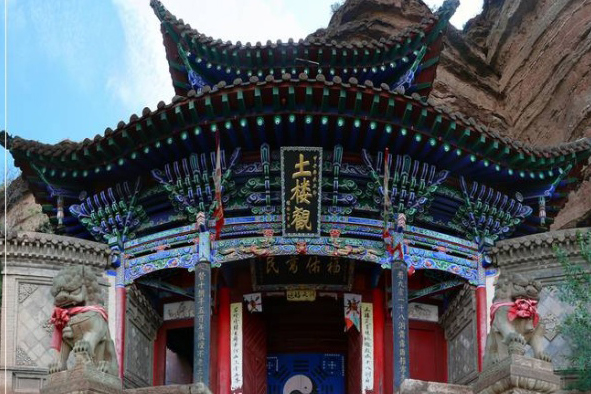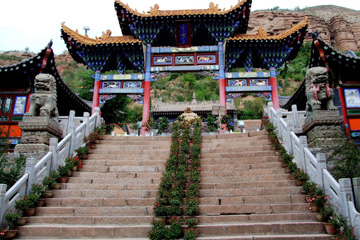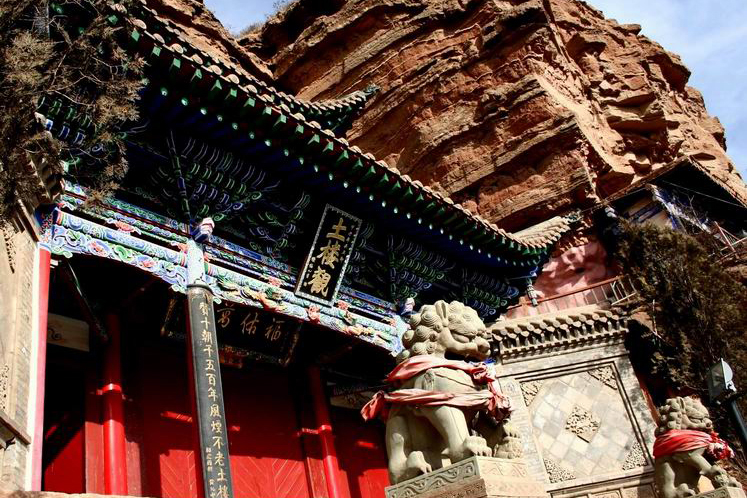Home > Attractions >
North Mountain Temple
Northern Buddhist Temple covers an area of 28,000 square meters (about 6.9 acres) and it leans against Northern Mountain (also called Tulou Mountain) in a northern suburb of Xining City, hence the name Northern Mountain Temple. Featuring Buddhist architecture and Taoist architecture styles it is renowned by its name 'A Bright Pearl on the Southern Path of the Silk Road.
Northern Buddhist Temple was constructed in Northern Wei Dynasty (386-534) and it is the earliest example of religious architecture in Qinghai Province. It was built based on a natural faultage on the mountainside according to Danxia Landscape featuring stone alternating between softness and hardness. Looking up you can see the crag and looking down you can see the cleft. Only the temple hangs in the middle, hence its other name Xuankong Temple (Hanging Temple). It is the second largest Xuankong Temple in China.
There are a total of 99 caverns with four layers including a single cave and cave groups inside Northern Buddhist Temple arraying from west to east. Residents call them the 'nine grottos and eighteen cavities'. They are connected by a plank road, which is built along a cliff, a small bridge, and a wandering corridor. Inside the caverns we can see frescos and sculptures carved on the wall. It is recorded that when Buddhism prevailed at the time, people were made to paint Zaojing design (a kind of decoration in the coping of the cavern) and the artistic frescos of Buddhism. These lifelike pictures comprise the contents of historical legend, fable, Buddhist ceremony and the chief of Buddhism. Inside some of the cave groups there are precious Tibetan Buddhism frescos. The temple is reputed as 'Xiping (the former Xining) Mogao Caves' and ranked as a National Key Protection Unit of Historical Relics.
In the middle part of Northern Mountain there were two huge figures of Buddha called 'Lutian Jingang' (Dorje in the open air). One has already collapsed but the other is still well preserved. The remaining one is more than 30 meters (about 98 feet) high and from afar we can clearly see his head, body, legs and facial features. This figure of Buddha was carved by many of his believers based on the original sculpt and form, and to some degree it reflects the artistic style of the Tang Dynasty.
At the top of Northern Mountain there stands a pagoda called Ningshou Pagoda, which is solid inside and is built of dark green brick. It has a hexagonal surface, five layers and turned up angles. When rainy days come, standing at Ningshou Pagoda you can see temples, groups of caverns and pagodas appear and hide alternately in the cloud and mist bringing us a sense of poetic and artistic imagery. This is an indistinct and boundless landscape renowned for its name 'Misty Rain of Northern Mountain' which belongs to one of Top Eight Scenic Spots in Xining City.
At the foot of Northern Mountain there is a temple called 'Lingguan Hall' which was once ruined by war and rebuilt in 1915. There is Mountain Gate, Wing-Rooms at both sides, a Horizontal Plaque on which the character 'Lingguan Hall' is written hanging in the center of the hall. It is said that two apprentices of a renowned Buddhist were buried at the west foot of the mountain which local residents called 'Buddhist Tomb'.
Since the Qing Dynasty whenever the Chongyang Festival (Double Ninth Festival) came, the civilians in succession went up the Northern Mountain to scatter paper on which was imprinted the Chinese character of '鹿' (deer) and '马' (horse) to worship the Buddha to imprecate safety and luck. Especially in recent years a great number of people gather together in Northern Buddhist Temple, which is decorated with lanterns and streamers in the evening of Chongyang Festival.
In previous times, Northern Buddhist Temple was only a Buddhist temple but later when Taoism was prevailing, it evolved into a Taoist temple. Every year there are swarms of Chinese from overseas who gather in Northern Buddhist Temple to join in the ceremonious pilgrimage and pay a visit
Northern Buddhist Temple was constructed in Northern Wei Dynasty (386-534) and it is the earliest example of religious architecture in Qinghai Province. It was built based on a natural faultage on the mountainside according to Danxia Landscape featuring stone alternating between softness and hardness. Looking up you can see the crag and looking down you can see the cleft. Only the temple hangs in the middle, hence its other name Xuankong Temple (Hanging Temple). It is the second largest Xuankong Temple in China.
There are a total of 99 caverns with four layers including a single cave and cave groups inside Northern Buddhist Temple arraying from west to east. Residents call them the 'nine grottos and eighteen cavities'. They are connected by a plank road, which is built along a cliff, a small bridge, and a wandering corridor. Inside the caverns we can see frescos and sculptures carved on the wall. It is recorded that when Buddhism prevailed at the time, people were made to paint Zaojing design (a kind of decoration in the coping of the cavern) and the artistic frescos of Buddhism. These lifelike pictures comprise the contents of historical legend, fable, Buddhist ceremony and the chief of Buddhism. Inside some of the cave groups there are precious Tibetan Buddhism frescos. The temple is reputed as 'Xiping (the former Xining) Mogao Caves' and ranked as a National Key Protection Unit of Historical Relics.
In the middle part of Northern Mountain there were two huge figures of Buddha called 'Lutian Jingang' (Dorje in the open air). One has already collapsed but the other is still well preserved. The remaining one is more than 30 meters (about 98 feet) high and from afar we can clearly see his head, body, legs and facial features. This figure of Buddha was carved by many of his believers based on the original sculpt and form, and to some degree it reflects the artistic style of the Tang Dynasty.
At the top of Northern Mountain there stands a pagoda called Ningshou Pagoda, which is solid inside and is built of dark green brick. It has a hexagonal surface, five layers and turned up angles. When rainy days come, standing at Ningshou Pagoda you can see temples, groups of caverns and pagodas appear and hide alternately in the cloud and mist bringing us a sense of poetic and artistic imagery. This is an indistinct and boundless landscape renowned for its name 'Misty Rain of Northern Mountain' which belongs to one of Top Eight Scenic Spots in Xining City.
At the foot of Northern Mountain there is a temple called 'Lingguan Hall' which was once ruined by war and rebuilt in 1915. There is Mountain Gate, Wing-Rooms at both sides, a Horizontal Plaque on which the character 'Lingguan Hall' is written hanging in the center of the hall. It is said that two apprentices of a renowned Buddhist were buried at the west foot of the mountain which local residents called 'Buddhist Tomb'.
Since the Qing Dynasty whenever the Chongyang Festival (Double Ninth Festival) came, the civilians in succession went up the Northern Mountain to scatter paper on which was imprinted the Chinese character of '鹿' (deer) and '马' (horse) to worship the Buddha to imprecate safety and luck. Especially in recent years a great number of people gather together in Northern Buddhist Temple, which is decorated with lanterns and streamers in the evening of Chongyang Festival.
In previous times, Northern Buddhist Temple was only a Buddhist temple but later when Taoism was prevailing, it evolved into a Taoist temple. Every year there are swarms of Chinese from overseas who gather in Northern Buddhist Temple to join in the ceremonious pilgrimage and pay a visit






